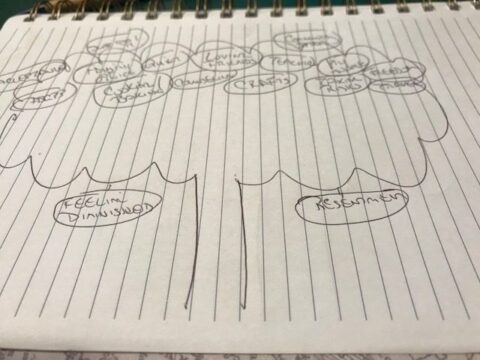For those of us in the northern hemisphere, September 1 marked the start of meteorological autumn. It’s a great time to harvest the things we wish to take forward in our lives and allow the rest to be left behind for rot and decay. It is the time for psychological shedding.
If we’re to go about this psychological shedding, we must begin by determining that which must be shed. What have you held onto that doesn’t belong with you anymore? Old resentments? A space in your heart for someone who’s not coming back and never truly deserved that space? The part of your life that’s the one you don’t like to face because it just feels gross and funky, but not that good kind of funky that makes us think of disco?
In this 5-part blog series, I’ll provide creative solutions you can use for a psychological shedding of that part in your life that needs no longer to be with you.
This week, you’ll begin the process of determining what stays and what goes.
Here’s what you need for psychological shedding:
- A few pieces of paper or a notebook that you can keep private
- A pen or pencil
Okay, let’s get started!
Picture yourself as a tree. Go with me on this one. You are a tree. It’s late summer. You’ve blossomed, leafed out, and fruited over these last several months. Your limbs are heavy from the burden of all you now carry. Much of it, you’ve chosen for yourself; while other parts you’ve not.

Draw the tree, leaving a lot of space in the canopy. It doesn’t need to be beautiful. This is self-help, not art class. Draw the two parallel lines vertically for your trunk and a bushy thing on top to represent the tree’s canopy. If you’re artistic, by all means, make a tree that’s as branchy and lush as you wish. Clearly, I am not artistic.

Spend a moment and notice the parts of life you chose for yourself. Notice first the good choices, the successes, the things that must remain with you. Think of a word or short phrase that captures each of these: “Kids,” “Hubby,” “Girlfriend,” “Mostly peaceful,” “House,” “Left him,” “Engaged,” “School,” “Rowing,” or whatever else. Place these words in circles around the top of your tree canopy. These are the positive fruits of your life. Save yourself room to continue listing these as they pop into your head over the next few days.

Next, notice the things that no longer belong with you, the parts of your life that have worn out their welcomes. There may be some that get your attention more than others: a bad relationship, a life problem you’ve carried too long, or something else. Again, think of a word or short phrase for them: “Resentment,” “Him,” “Her,” “Job,” “Jealousy,” “Toxic sister,” “Sorry for myself,” whatever. Cluster these items toward the bottom of the tree’s canopy. These are the negative fruits of your life choices.
Look at your tree and decide if, for now, this looks like a full enough representation of the choices you’ve made for your present life. If you struggled to complete the top half of your canopy but ran out of room from all the rotten fruit hanging at the bottom of it, this blog may be especially timely.
Over the next week, spend some time thinking about the positive choices that are reflecting in your life and continue to list these fruits in the top of your tree canopy. Being clear on our strength, our positive choices, and our ability to continue deciding good things for ourselves is essential to mental health. Just as there are things that are overripe for psychological shedding, there are those parts of our lives that we need to honor, celebrate, and carry forward.
To prepare for psychological shedding, I want you to also really consider that one item in the bottom of the tree’s canopy that you’re ready to drop. This is the fruit that’s most rotten and ready to be fed to the worms from whence it came.
Of course, it’s the case that all the stuff hanging at the bottom deserves to drop. For now, pay attention to that one worst fruit in your life. Once you’ve let that first rotten fruit drop and decay, your tree gets a little healthier, stronger. Others will follow in time. This happens when we begin the healing process for our lives. It’s a natural occurrence. We get healthier and refuse to tolerate areas of our lives that hinder us. We become more skilled at psychological shedding.
Get clear on this. What’s the one thing on your tree that bothers you most?
Follow next week’s blog, “Letting Go of Rotten Things,” when we’ll be dropping that biggest and nastiest fruit from your tree.


